Norwegian extreme metal band Darkthrone have been shrouded in mystique ever since their 1986 inception. The band's second, third, and fourth albums, A Blaze in the Northern Sky, Under a Funeral Moon, and Transilvanian Hunger—released in 1992, 1993, and 1994, respectively—are commonly regarded as the unholy trinity of black metal. But the band no longer consider themselves purely black metal, and it's questionable as to whether they ever did. They've arguably jumped around stylistically for their entire career—from death metal to doom metal to black metal, and even crust punk, as evidenced on 2006's The Cult Is Alive. They never tour or perform live (their last performance was in 1996), which defines their sound just about as much as any musical influence, as they've long chosen to focus their creative energy on crafting albums in their own makeshift studio, which was located in an old bomb shelter in their hometown, Kolbotn.
Since Transilvanian Hunger, there have been only two members: Nocturno Culto (Ted Skjellum) on guitar and Fenriz (Gylve Fenris Nagell) on drums. Both somewhat reclusive, they work in seclusion from each other when songwriting. Fenriz has a reputation for being ornery and interview anemic, though he hosts the Fenriz Metal Pact radio show/podcast. (He was also elected to sit on his town council after posting a photo with his cat and the slogan "Don't Vote for Me.") Nocturno Culto, who often serves as the band's primary engineer, is more affable.
Darkthrone - Eternal Hails...... (2021) FULL ALBUM
Darkthrone's latest album, Eternal Hails, throws yet another plot twist into their hallowed career. Their 19th release, it's not what one might expect from the most acclaimed progenitors of black metal. The album is brimming with musical and sonic nostalgia that harkens back to an earlier, more formative style of traditional '80s heavy metal and thrash. The word "organic" is often bandied about nowadays to convey something as more real or natural, but Eternal Hails truly earns that descriptor. In contrast to modern metal's penchant for digital enhancement, from quantized drumbeats to auto-tuned vocals, Eternal Hails sounds primitive, like a good, old-fashioned heavy metal record.
There's a loose feel to the performances that gives the heavy guitar riffs a bit of swing, as if they're evoking Black Sabbath. Nocturno Culto attributes this to the lack of a click track. "Since 1987, we have not used any metronome," he says. "That is part of why it sounds organic. It would make no sense to play with a metronome, because, since we started releasing albums—especially since 2005, when we got our own studio—we have this habit of recording one [rhythm] guitar and drums live, and that is what gives us pleasure, to play together." Sure, one could map it all out on a grid in Pro Tools, but that's not the headspace Darkthrone occupies. Fenriz, whose role, in addition to playing drums, has been writing guitar riffs and lyrics, sums up their recording strategy like this: "It's letting yourself be open to coincidence. Throw caution to the wind. It is more important the recording sounds alive, with nerve—that there are people actually playing this [material] in one or two takes."
If a riff sounds good without fuzz, it will most certainly sound killer with fuzz."–Fenriz
Similarly, Sabbath-esque, dark, foreboding songs such as "His Masters Voice" and "Hate Cloak" traverse soundscapes that bound from one section to another, avoiding formulaic verse-chorus song structures. The duo also seem to slow down their pulse from their previous work. "We both feel better [nowadays] playing mid-tempo and slow," explains Fenriz. "All of Ted's songs have slow parts, and all of my songs have slow parts. Ted added the more complex rhythms and strange riffs on 'Voyage to a Northpole Adrift.' I had a complex break in 'Hate Cloak,' but I usually thrive in 4/4—wanting to fill the 4/4 timeframe with as much primitive metal as possible."
With the band's bomb-shelter studio now condemned, Darkthrone were forced to use a commercial studio for the first time since 2005. They chose Oslo's Chaka Khan Studio, where they learned that it's easier to be creative when you have help. "We can go off the initial plan, like in the last part of 'Lost Arcane City of Uppakra,' and create something otherworldly," explains Fenriz. Nocturno Culto concurs, citing that it was a "nice experience to just play guitar and be a musician" without the extra pressure of engineering the sessions, too. But both admit that it also made them nervous to have other people around. "It was 17 years and seven albums with just the two of us in the studio before Eternal Hails," says Fenriz. "We were adamant that we made Ole and Silje [Ole Øvstedal and Silje Høgevold, who engineered Eternal Hails] our friends, too, and not try to boss them around in the studio. We were very hands off. It was the exact opposite of going to a pro studio where many metal bands have been before, and where you know what sound you will get. This was unchartered [sic] territory." Nocturno Culto adds that the older equipment at their disposal at Chaka Khan also allowed them to achieve their desired results. "Take the echo on the vocals. It's not a plug-in. It's this old tape echo recorder," he says. "It's a bit more difficult to have perfect control over it, but we like our studio recordings to live their own life, and we have a vision when we go into the studio."
Nocturno Culto's Gear
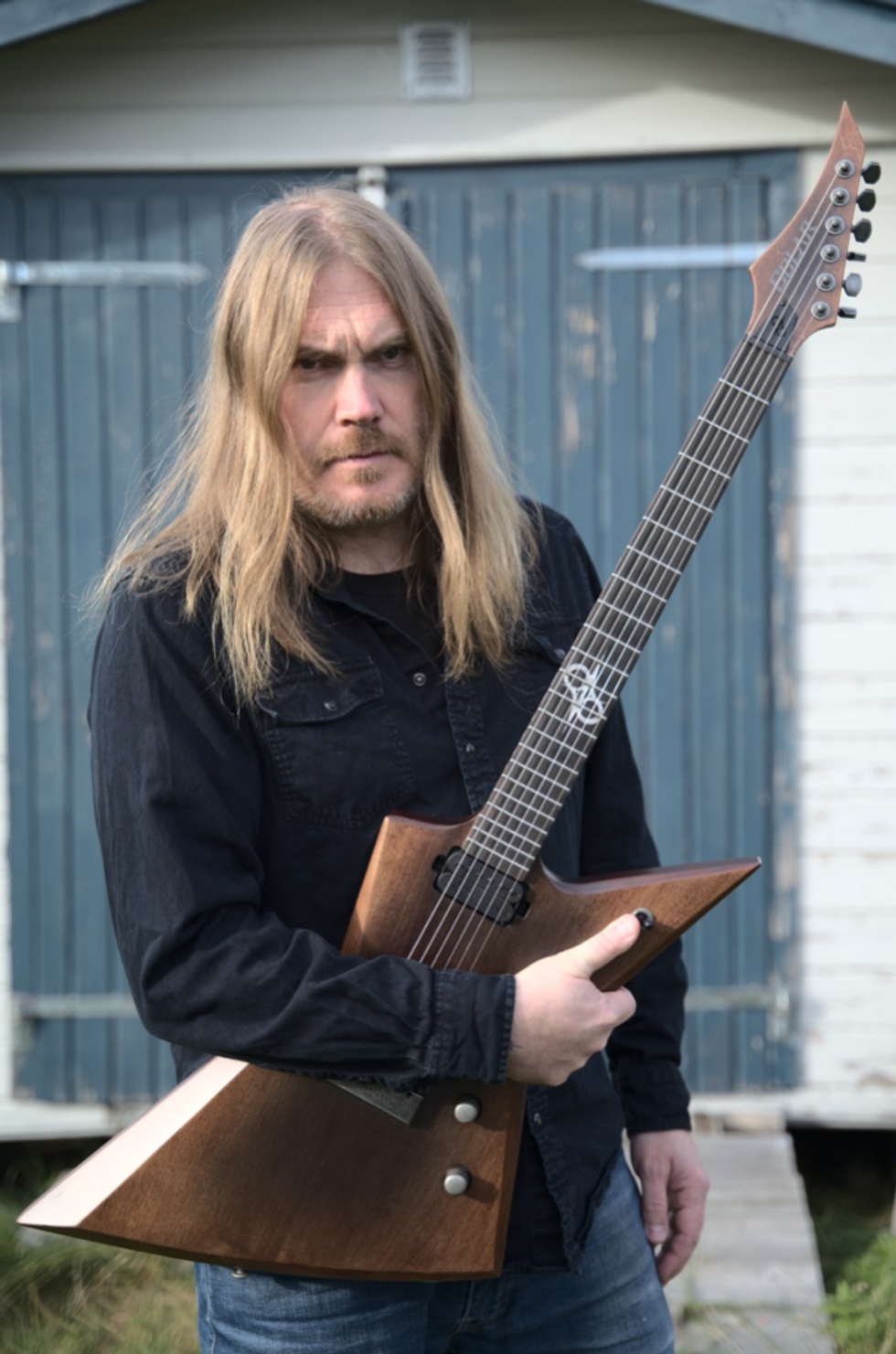
Nocturno Culto and his Solar Guitars E1.6D LTD scowl at the camera.
Photo courtesy of Solar Guitars
Guitars
- Solar Guitars GC1.6FAB
- Solar Guitars E1.6D LTD
- Rickenbacker 4004 Bass
Effects
- Tube Works Blue Tube
- Fulltone Custom Shop Tube Tape Echo
- Thermionic Culture Freebird 3-channel tube-EQ
Amps
- 1972 Hiwatt SA212 with Celestion Sidewinders
- WEM Clubman MK8 with a Celestion Sidewinder
- Avalon AD2022 Dual Mono Pure Class A Preamplifier
- Groove Tubes STP-G Studio Preamp
- Universal Audio Teletronix LA-2A Classic Leveling Amplifier
Strings and Picks
- D'Addario (.010–.052)
- Dunlop .73 mm Nylon Standard
Both band members thought it would be in everyone's best interest to provide the engineers with a couple of albums as a sonic reference point, and it's a revelation to learn which albums they furnished, because, surprisingly, they were not their own. They were Ride the Lightning by Metallica and American doom-metal band Trouble's self-titled fourth album. "Not that we wanted to copy their sound," clarifies Nocturno Culto, "but something to point in the direction of the drum sound and the overall feel." If something hints at a nostalgic element in Eternal Hails, it is likely derived from those two albums.
The overall production aesthetic is important to Darkthrone, even when working with outside engineers. "You want to create its own space, to take the listener to," says Nocturno Culto. "If you see a big painting, you can say that the actual painting is the music. But every good painting has a frame that has to fit and provide an overall experience of watching that painting. And so for us, the frame is the sound. Some people say, 'Let's have a plastic frame, it works.' But it doesn't work for us. We have to carve the little things out and try to make a cozy place out of it."
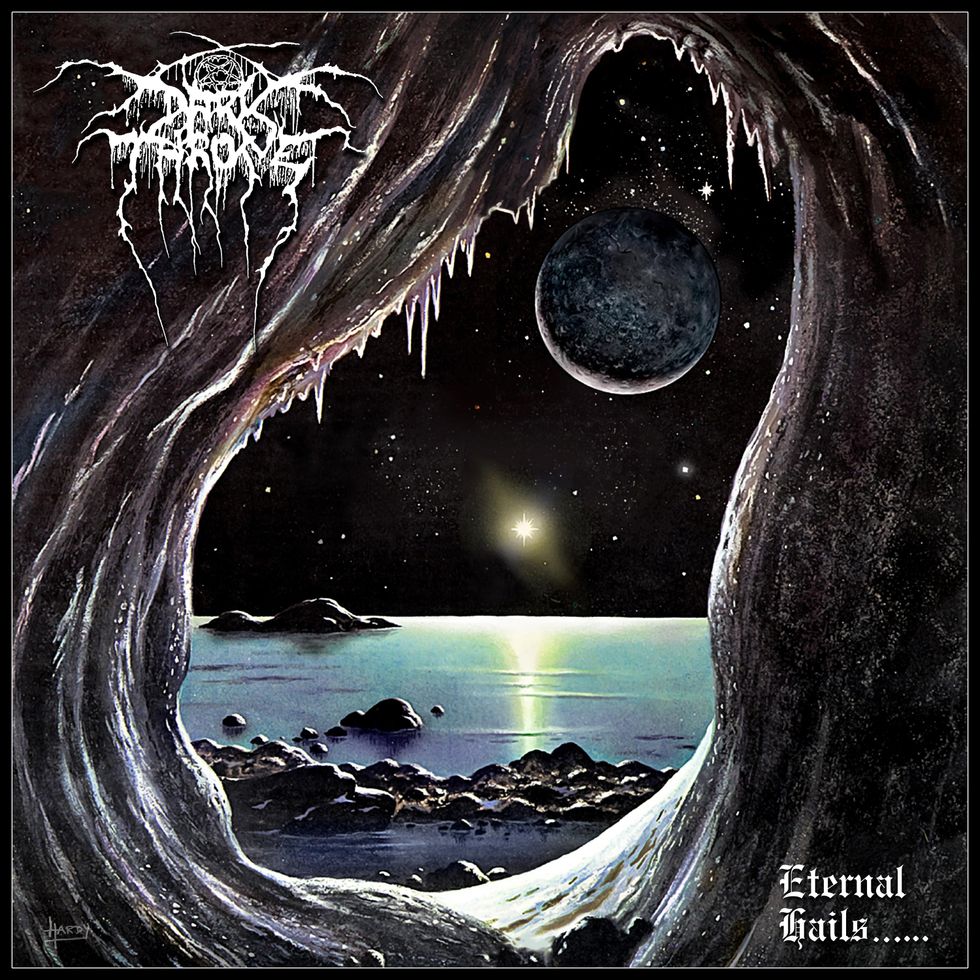
TIDBIT: With their bomb-shelter studio condemned, Nocturno Culto and Fenriz recorded Eternal Hails—the 19th Darkthrone release—at Oslo's Chaka Khan Studio. It was their first time in a commercial studio since 2005.
While songwriting, Nocturno Culto and Fenriz work separately and spend plenty of time preparing before they begin recording. "Being the only guitarist, I have to basically learn [Fenriz's] riffs quite fast," says Nocturno Culto. "For me, it's important to play a lot of guitar [before going into the studio] and be on top of my game, because there's a lot of things in the studio I have to cut straight away." For Fenriz, he likens his songwriting process to more of a filing system. "I don't know anything about Ted's creative process, but I imagine he sits down to write," admits Fenriz. "I just get my riffs in any situation possible—'Hate Cloak' and 'Lost Arcane City of Uppakra' came after a long hiking trip—so there's nothing else to do than to hum them into my recorder, or play them with my guitar."
For Fenriz, guitar is simply a "vehicle" for writing songs and not something he necessarily aspires to be good at. "I play guitar very loosely and sloppy," he confesses. "I am bad at repetition and bad at copying even my own riffs. I have to take this into consideration, since Ted plays much more militant and sternly, so whenever I make some weird funky detail, I can only hope that it is played in the vicinity of what I originally wanted." Fenriz says he was, arguably, a better guitar player in the past than he is now, but that it didn't necessarily make him a better songwriter. "I didn't make better material. I just made more material," he assesses. "When I am constricted by my Fenix [guitar], which is hard to play, and my lack of skills, it seems I use my brain more for creative angles of primitivity, and I think the riffs are better, and the assembly of the songs are better and more interesting." He also, maybe surprisingly, writes without fuzz. "If a riff sounds good without fuzz, it will most certainly sound killer with fuzz," he concludes.
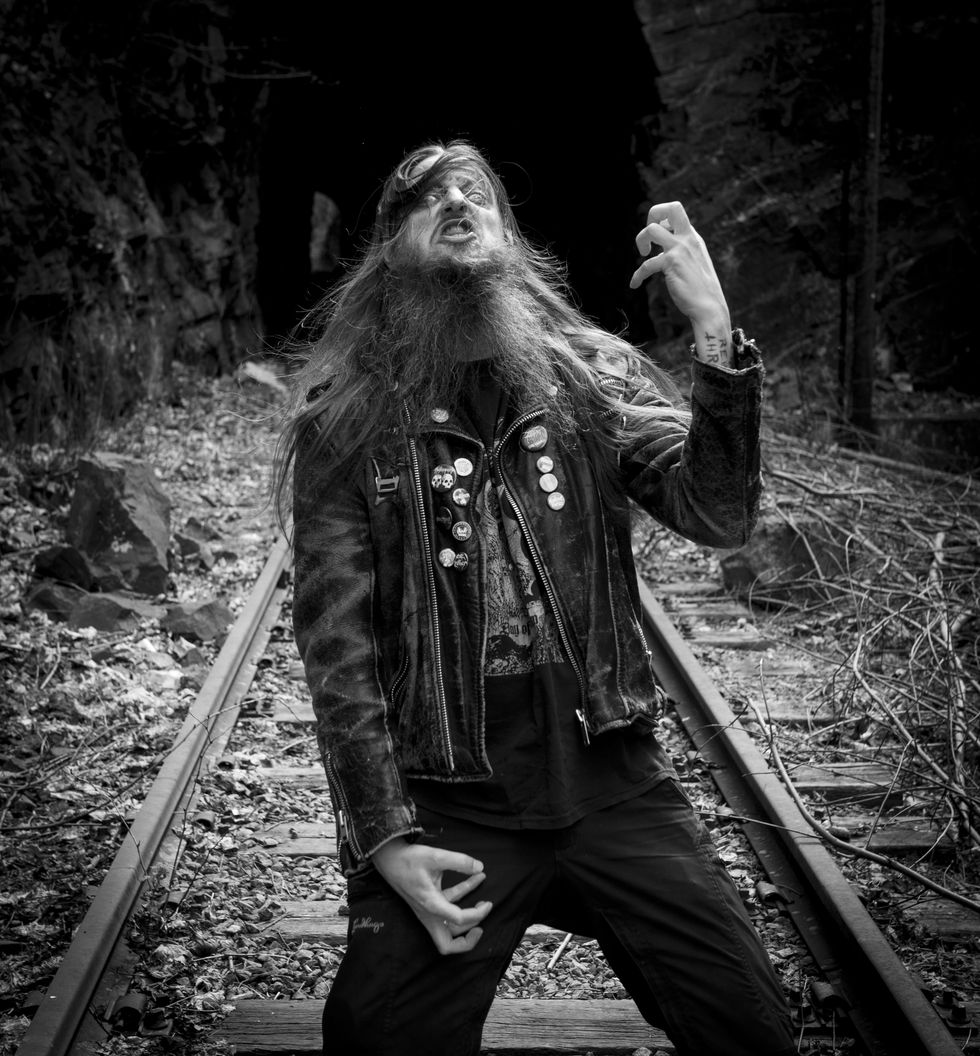
Fenriz plays drums on Darkthrone's albums, but co-writes the band's songs on his Fenix guitar, not seen here. "When I am constricted by my Fenix, which is hard to play, and my lack of skills, it seems I use my brain more for creative angles of primitivity," he says.
Photo by Jørn Steen
Nocturno Culto, however, is the sole guitarist on Darkthrone albums, and also played bass on Eternal Hails. He draws from a deep well of inspiration, including some unexpected influences, claiming ZZ Top's Billy Gibbons as one of his biggest guitar heroes, in a surprising twist to the band's musical DNA. But listen closely and there's evidence of Gibbons' bluesy swagger, particularly in his rhythm chops. "There's just something about his playing," he says. "I really dig the '70s ZZ Top. His playing there is absolutely stunning. And that goes for the rest of the band as well. When you hear the drummer of ZZ Top, in the '70s, he's holding a low profile, but when you listen enough to ZZ Top, you understand he's a really fucking good drummer—he's amazing."
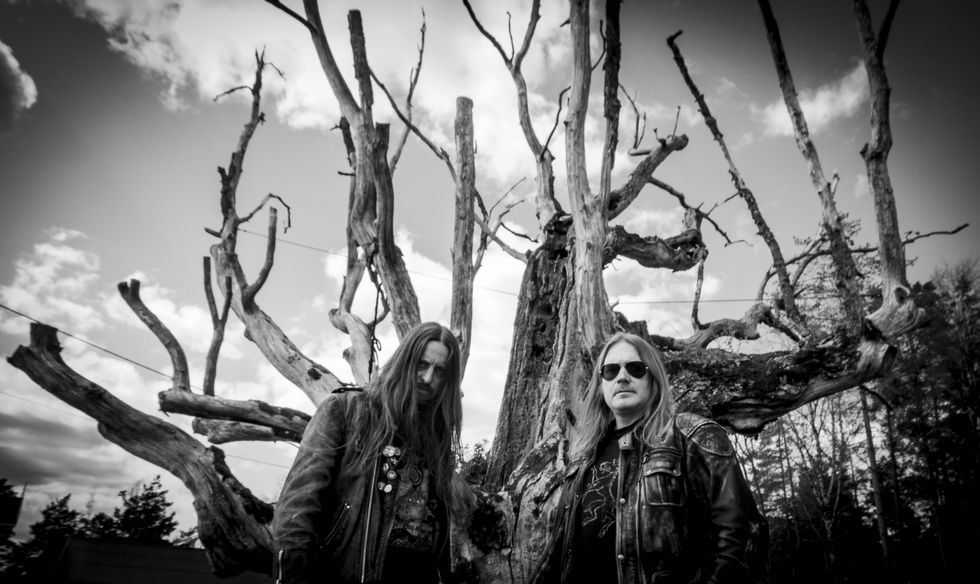
Darkthrone are among the prominent progenitors of Norwegian black metal, but label Eternal Hails' genre as Black Epic Heavy Metal
Photo by Jorn Steen
The ultimate question is whether the duo consider Eternal Hails to be black metal. Nocturno Culto says, "I don't think we consider ourselves black metal, but I think there is always black metal riffing somewhere on the records." Fenriz highlights a common denominator between all their albums. "Since the first demo, we've been displaying a wide variety of influences. However, the vocals often tie it together and display a more die-cast impression, leaving the total picture to sound less varied than it actually is, perhaps." He adds that during the writing and recording process, the band would joke that the genre label for Eternal Hails is "Black Epic Heavy Metal." Nocturno Culto concludes, "No matter what we do, I think we always end up sounding like Darkthrone."
YouTube It
Here's a rare opportunity to see Nocturno Culto play through "The Key is Inside the Wall" from 2019's Old Star on his Solar Guitars GC1.6FAB. The band hasn't performed live since 1996.
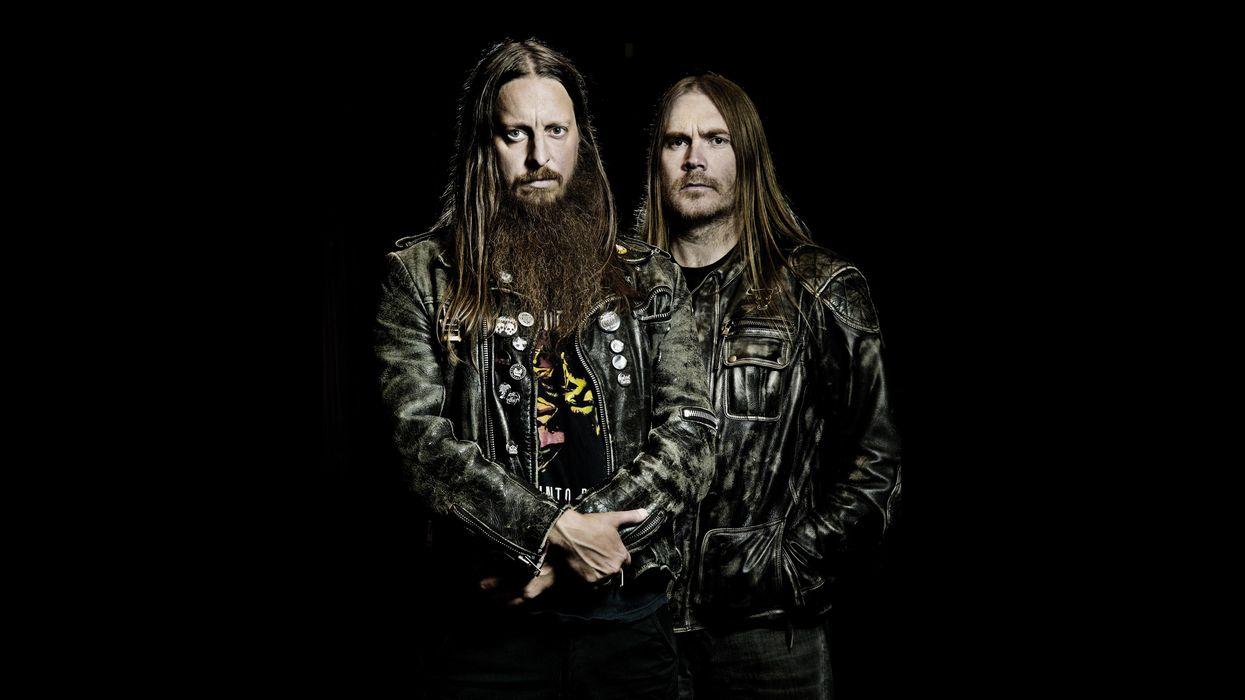




















![Rig Rundown: AFI [2025]](https://www.premierguitar.com/media-library/youtube.jpg?id=62064741&width=1245&height=700&quality=70&coordinates=0%2C0%2C0%2C0)








 Zach loves his Sovtek Mig 60 head, which he plays through a cab he built himself at a pipe-organ shop in Denver. Every glue joint is lined with thin leather for maximum air tightness, and it’s stocked with Celestion G12M Greenback speakers.
Zach loves his Sovtek Mig 60 head, which he plays through a cab he built himself at a pipe-organ shop in Denver. Every glue joint is lined with thin leather for maximum air tightness, and it’s stocked with Celestion G12M Greenback speakers.












![Devon Eisenbarger [Katy Perry] Rig Rundown](https://www.premierguitar.com/media-library/youtube.jpg?id=61774583&width=1245&height=700&quality=70&coordinates=0%2C0%2C0%2C0)






